7 Ways Technology Is Used In Birding (With examples!)
We’re reader-supported; we may earn a commission from links in this article.
Birding has seen lots of improvement in terms of its technologies in the 21st century and it is growing rapidly as I type this article. We birders need to keep up with the times to understand the tech out there so we can make full use of them! I did some research on my own and found some really interesting birding tech! Here’s what I found:
List of Birding Technology:
- Birding Listing Software
- Birding Apps
- Birding Databases
- Birding Games, Augmented Reality (AR) and Virtual Reality (VR)
- Advanced Birding Gear
- Remote Monitoring For Research
- Data Science in Birding
1. Birding Listing Software
When birding, all birders should know that we would all keep our own list of birds that we’ve seen before, also known as the lifer list or bird list. Though birders in the past used to keep all of these records on pen and paper, ever since the turn of this past decade, web technology has been booming which allowed for storage of these list in digital format.
Birding listing software such as the SCYTHEBILL software is free software that allows birders to not only store their bird lists in a digital format but also to offer interesting insights and details of birds that they’ve spotted before and potentially will spot in the future. The best part about this kind of software is how easy it is to look up when and where you’ve spotted a certain bird exactly. In the past, if you would keep a thick notebook of all the birds you’ve seen before, then it would be really tedious to try and backtrack where you’ve done so. With the advent of such technology, the search process has become much easier.
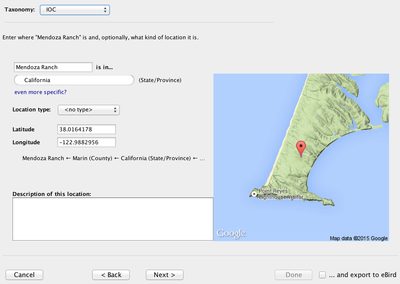
However, birding listing software used to see its glory days in the late 2000s when the smartphone had not yet been invented yet. Birders in the past may still find it inconvenient in that they would not be able to document their findings immediately while they were out in the field, as opposed to a desktop at home in their birding listing software. There were many other examples of birding listing software, but upon searching them up on google, I realized that many of their developers have stopped their support for their software and can no longer work properly on modern computer systems.
Here’s also a video on how the interface looks like:
2. Birding Apps
In the past decade, the iPhone was first invented by Apple Inc. in 2007. That was when everything changed. Birders could see the value in being able to document their findings and data more easily in portable birding app. In the past few years from 2010 to 2020, there have been massive developments in different kinds of birding apps used for purposes such as field guides, bird song identification, bird identification, citizen science, song-learning, and apps used to store life lists. This provides an advantage for birders who like to document and search up their bird in question, without having to flip through thick field guide books! Here are some examples:
Birding Field Guide Apps
Some examples of birding field guides available in apps include the Sibley eGuide to the Birds of North America, the Audubon Bird Guide, and the iBird app. While the Sibley guide and the Audubon guides were based on their hard-copy original versions, the iBird app is only available in the app format.
Here’s a table to compare some of them with some links so you can check them out!
| Bird Guide Apps | Price | Platform(s) | Details | Video Demo Link |
| Sibley eGuide to the Birds of North America | $19.99 | iOS, Android, Kindle Fire, Windows, and Blackberry | – Only covers birds in North America. – Covers 810 species with illustrated drawings as seen in the original paperback guide – Houses 2000 bird calls and songs – Has a search tool to filter by color, shape, and location | Link at the 8.45 |
| Audubon Bird Guide | Free | iOS, Android, Kindle Fire, HP, and Nook | – Covers birds worldwide – Covers 810 species with illustrated drawings and more detailed descriptions than in the original paperback guide – Has a ‘find birds’ function which uses eBird, a citizen science birding database, to identify likely nearby species | Link |
| iBird | $2.99-39.99 (free Lite version) | iOS, Android, Kindle Fire, and Windows | – Covers birds worldwide – Covers 940 species in the pro version with illustrated drawings and more highly detailed descriptions and information of bird such as their behavior, nesting, ecology, and eggs – Has a powerful search tool | Link |
Below are some screenshots of the apps I mentioned in the table above! Links are in the names of the apps above!
Sibley eGuide to the Birds of North America
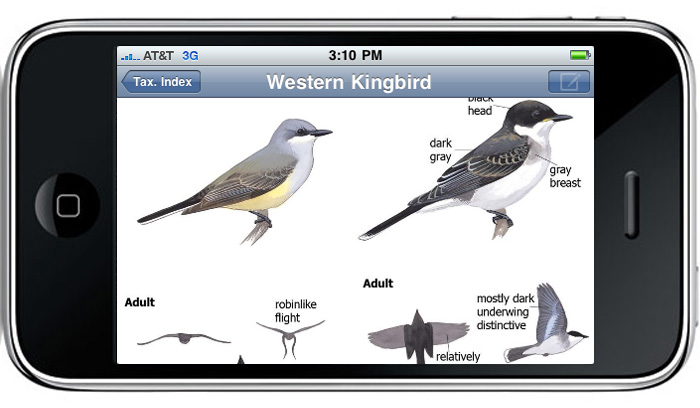
Audubon Bird Guide App

iBird
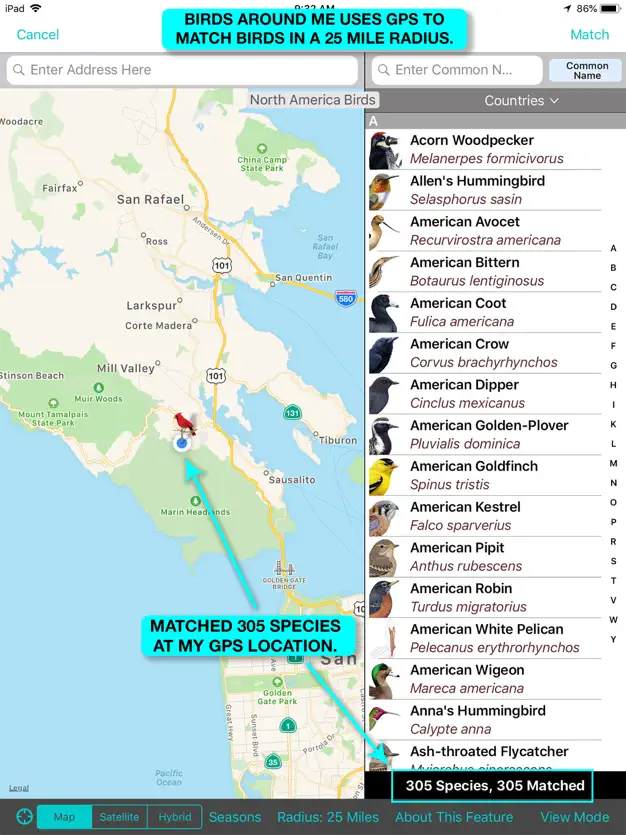
Bird Identification Apps
Technology has now taken away one of the most difficult tasks for beginner birders: bird identification. As a beginner birder who started birding just recently too, I struggled with identifying birds because of how they seemingly looked very similar, ESPECIALLY shorebirds! I’m sure many of you birders can also identify with that right? Well, now with computer vision technology employed using bird photo data, data scientists and ornithologists have put together very robust bird identification algorithms which help us identify birds easily!
Below are a few examples:
| Apps | Pricing | Platform(s) | Details | Video Link |
| Merlin Bird ID | Free | iOS and Android | – Contains a large number of birds for countries all over the globe. Each country/area will have its own extension known as ‘bird packs’. – Bird ID function puts the user through a questionnaire to determine the likely identity of the bird – Photo ID function uses computer vision technology to identify birds based on computer vision trained from large datasets – Both Bird ID and Photo ID generate a list of likely birds that you are trying to identify based on location, size, color, time of year, etc. – Explore birds and life list functions are useful for simple information about birds and storing life lists that are synced with Ebird life lists | Link |
| BirdNET | Free | iOS and Android | – A simple Proof-Of-Concept app that analyzes bird sounds and calls – You can highlight a specific portion of your recording in which you want to analyze to single out a single bird call – All data submitted will be sent to a server in Germany to process in real-time to identify your possible bird – List of birds identified will show a certain likelihood – Highly accurate | Link |
Here are some pictures of the apps I mentioned in the table above:
Merlin Bird ID App
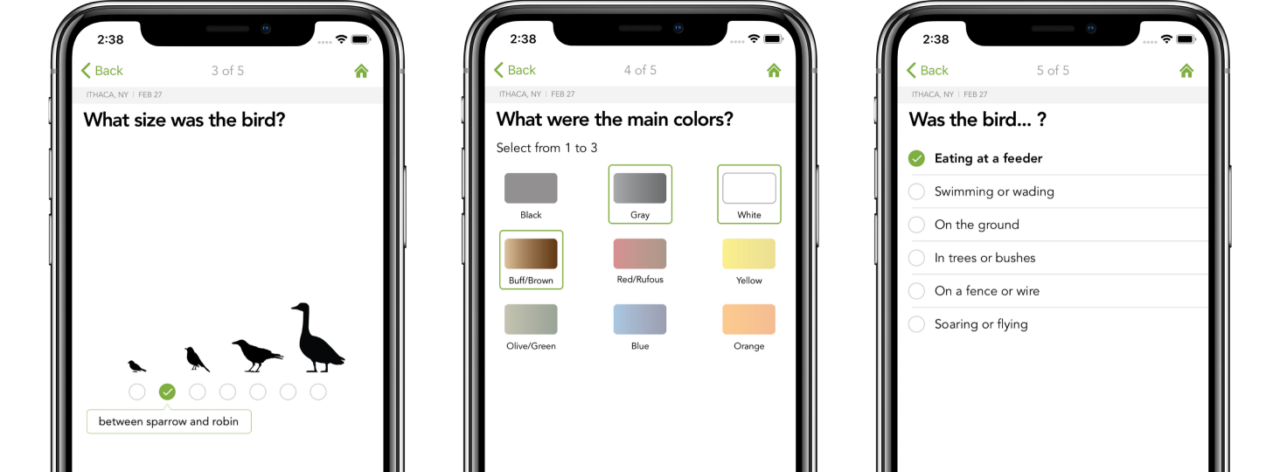
BirdNET App
If you’re interested in more bird identification apps and their details, you can read another article I wrote on 5 great bird identification apps you can use.
Citizen Science Apps
If you’re not familiar with the term ‘citizen science’ then it’s okay! I recently got to know of this definition too! It’s actually the voluntary participation of normal citizens in scientific research. It’s as simple as that. This mostly consists of participating in monitory stints and data collection exercises. The data collection is then analyzed by scientific professionals. Recently, apps have been a great platform for scientists to reach birders and vice versa. Here’s one example of the biggest citizen science app: eBird
| App | Price | Platforms | Details | Video Demo Link |
| eBird | Free | iOS and Android | – eBird is a citizen science program set up by the Cornell Lab of Ornithology to record bird observations from birders around the world. – This app tracks and collects all the data that you key into the app and shares them with other birders and naturalists. – The Great Backyard Bird Count is done on this app and is a great way for beginner birders (like me!) to participate just for fun! – My eBird function allows you to keep a record of the birds you’ve seen – Explore functions allows you to learn about birds seen in the area | Link |


3. Birding Databases
So you might have wondered how we store so much data since we record so many sightings and information about birds right? All this data is actually stored and kept in worldwide databases available online. With the advent of new technological advances in the internet, information on birds is not just confined to illustrated field guides you buy off the bookshelves. I’ll be giving you some screenshots of my favorite bird: the Large-tailed nightjar.
Here are some databases that may help you along with your birding journey as they allow for quick search queries and are full of information beyond just pictures in books:
| Database | Price | Platforms | Details |
| eBird | Free | iOS, Android, and online | – eBird is a citizen science program set up by the Cornell Lab of Ornithology to record bird observations from birders around the world. – This app tracks and collects all the data that you key into the app and shares them with other birders and naturalists. – The Great Backyard Bird Count is done on this app and is a great way for beginner birders (like me!) to participate just for fun! – My eBird function allows you to keep a record of the birds you’ve seen before – Explore function allows you to learn about birds seen in the area – Online database has a really nice interface with lots of pictures, illustrations, bird sounds, and videos |
| Avibase | Free | Online | – Lists extensive lists of birds with translations of species names in many languages (including Asian languages) – Contains 45 million records about 10,000 species and 22,000 subspecies of birds, including distribution information for 20,000 regions – Includes many embedded extensions to other webpages such as eBird and Wikipedia – Has detailed records of taxonomic history and nomenclature – Includes photos from Flickr and audio from xeno-canto, macaulaylibrary.org & avocet.zoology.msu.edu. |
| Birdata | Free | iOS, Android, and Online | – Contains more detailed descriptions of birds in Australia – Includes live bird data on a map |
| Xeno-Canto | Free | Online | – A database of bird sounds, calls, and song database contributed by birders – You can download audio files from each recording – Each recording is listed with a recordist, country, location, and remarks on the bird’s activity |
Here are some pictures of the different database websites. Links are in the database names in the table above!
eBird
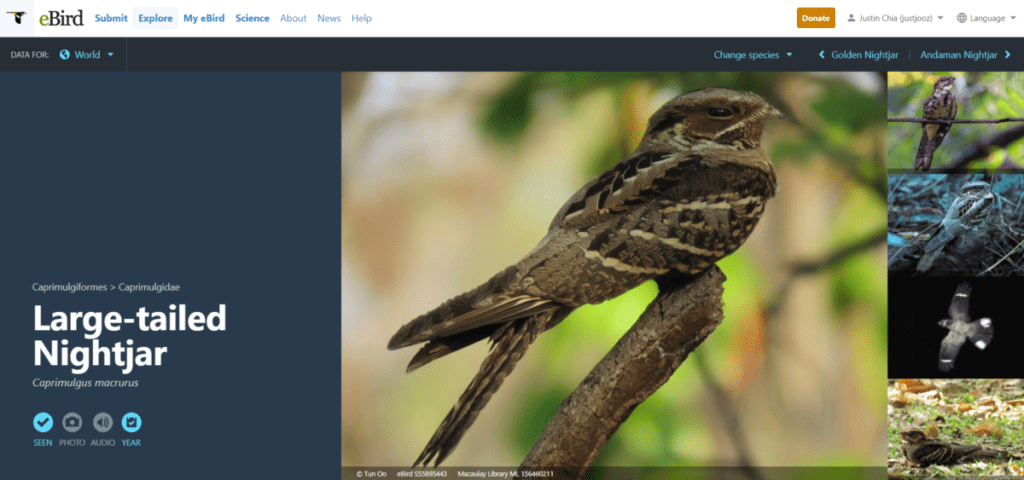
Avibase
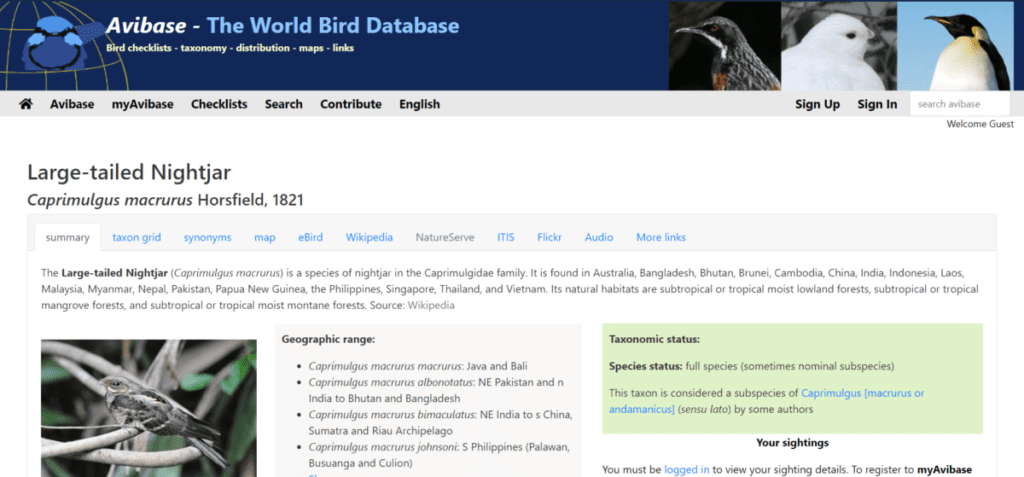
Birdata
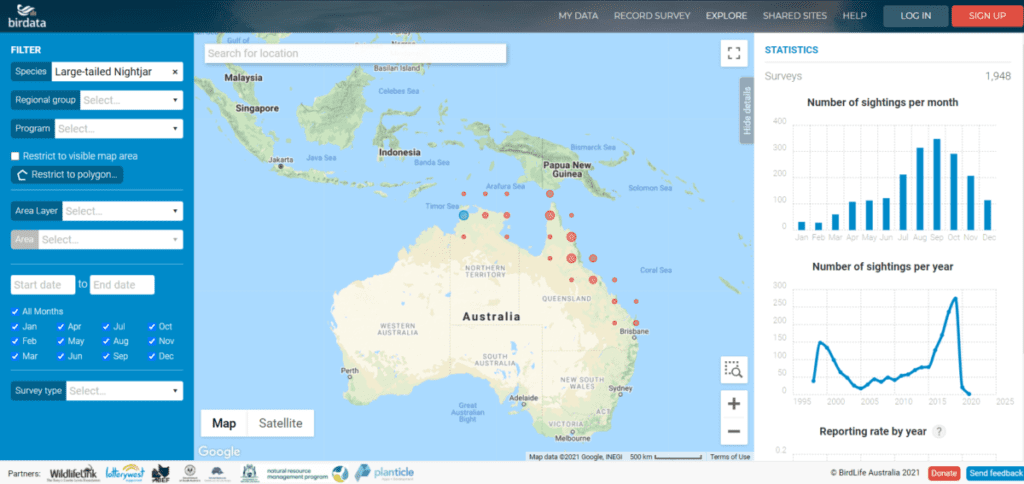
Bird Base
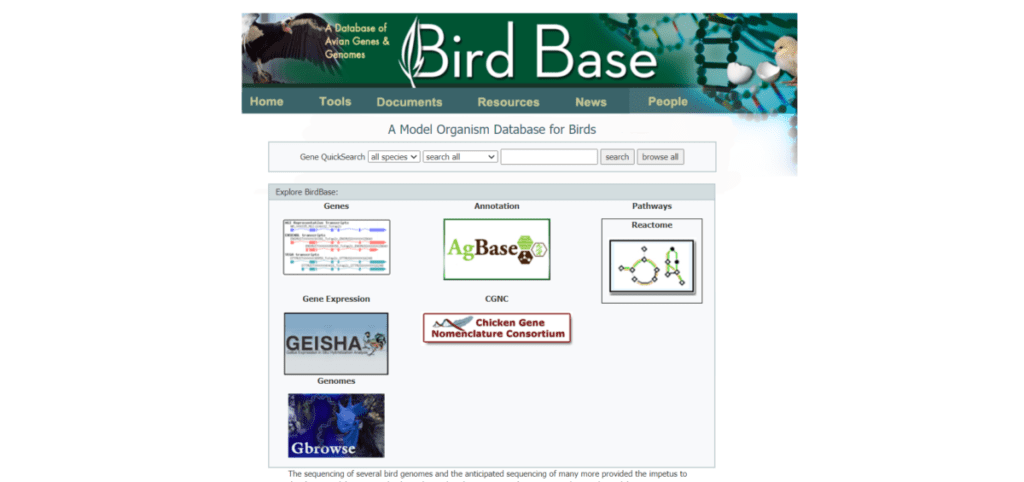
4. Birding Games, Augmented Reality (AR) and Virtual Reality (VR)
Now if you’re also an avid gamer like me, then this portion of this article will definitely suit you! Birding has always been an outdoor hobby and activity for the most part in the past few years. However, in recent developments in game development, AR, and VR, birding has also gone virtual!
Now if you didn’t know what AR or VR meant, here’s a quick explanation: Augmented Reality (AR) is a technology that places a computer-generated image onto a physical space in the real world. If you’re familiar with Pokemon Go, then you would already know AR. Virtual reality, on the other hand, is a technology that simulates a situation where a person can interact within a virtual 3D space using devices and goggles. Ok, I’ve got some exciting examples to share, so let’s dive right into it!
Wingspan AR game: Krikey
Wingspan was originally a best-selling board game for birders who want to experience and emulate the outdoor birding experience indoors. It is actually a game that challenges players to attract the most bird to a birdfeeder tower and ultimately win by garnering the most point after 4 rounds.

However, with the rapid expansion of AR capabilities in recent years, an AR version of this board game was produced: Krikey. Players will be able to see and interact with AR birds in real-time using their phones alongside the game. The birds are mapped in real-time space using computer vision so that they seem that they are interacting with the environment.
Here’s a trailer of Krikey:
Pretty amazing right? Who needs Pokémon Go when you have wonderful virtual feathered friends! You can check this app out for yourself as it’s available free on both iOS and Android.
Guard@Lis Mobile AR Application
Guard@Lis [1] was created as a mobile AR application for the purposes of birdwatching to help people find and identify bird species, promoting the preservation of their habitats! The app was defined to lead players along routes where they would see birds that are commonly seen in that area. This application was first created for the city of Leiria, Portugal. I’m not sure if it’s because of country restrictions that I can find the app in the Google Play Store and Apple App Store.
Here are some screenshots of the app based on the paper that they produced:
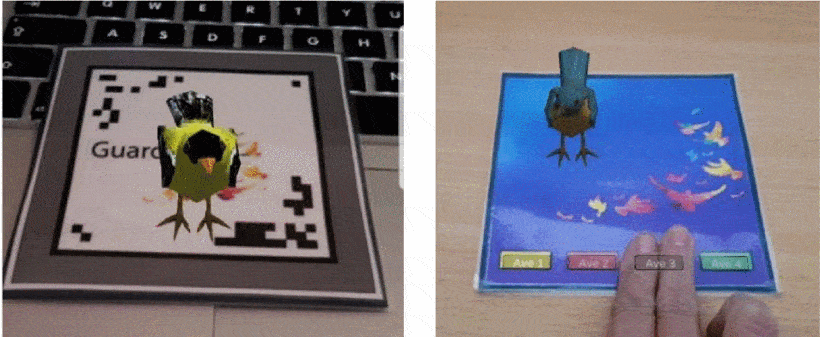
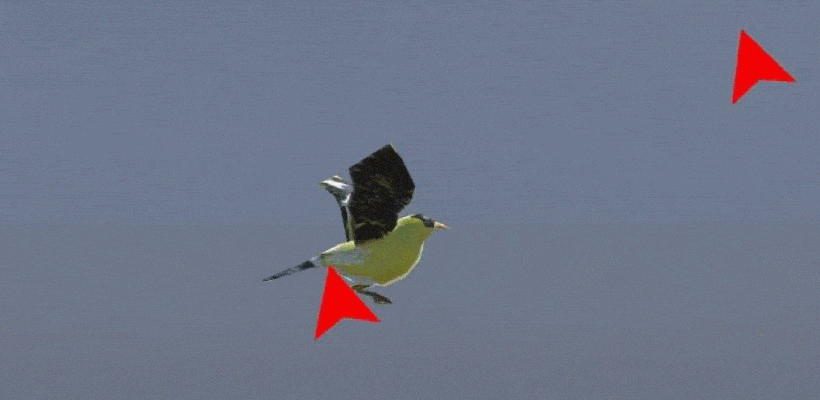
Bird Watch VR Game
Bird Watch is a VR game that was created for educational purposes to teach citizens of the top 10 common North American birds. The game takes us through relaxed and repetitive actions to improve real-life bird identification skills, promoting increase appreciation for the hobby. You should check out their published article to watch a short video demonstration of the game. It gives me lots of Nintendo vibes!
Here are some screenshots of the game!

Welcome Above VR Bird Simulator Game
If you’re tired of just watching birds and doing just bird watching, you can also choose to be a bird these days. With advanced graphics technology, you can actually simulate the flight of a bird that you’ve always dreamt of. I’m sure every birder has once wanted to fly around environments freely like a bird. Well, now, you can! Here’s a video demonstration of the game!
Eagle Flight VR Bird Simulator Game
Here’s another more beautiful example of simulating bird flight, but this time, you get to be born as an eagle hatchling and learn how to fly in virtual environments! I personally am super intrigued by this one and will definitely try it out if I have the chance to one day!
Here’s a video of the gameplay:
Fantasy Birding Websites
If you’ve heard of fantasy football, you are not far off from understanding what fantasy birding is! Fantasy birding is basically a game for armchair naturalists. How it works is that you choose the desired location to go ‘birding’ in the game, then the game pulls real weather data and recent bird sightings from real birders in that particular area from eBird.
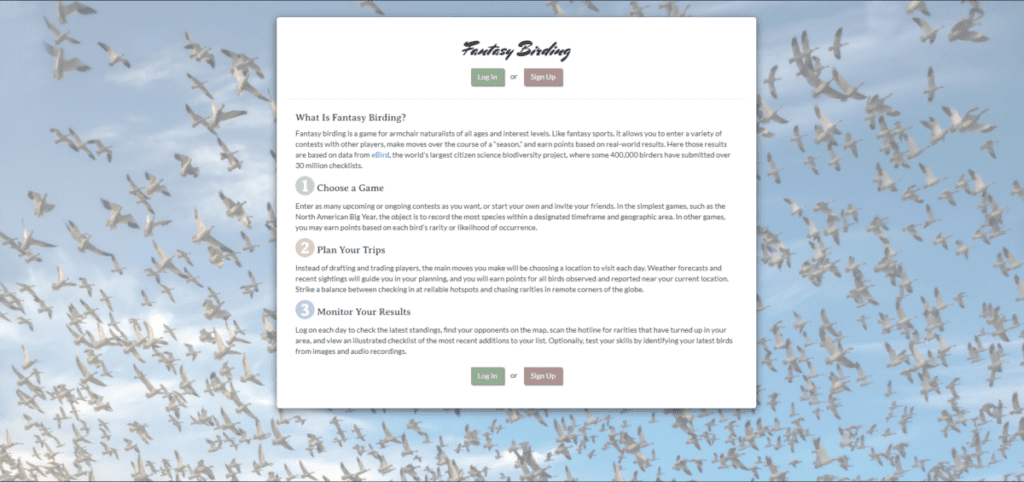
The competition in the game is to see who is the one who can get the most number of birds spotted in a particular area during a Big Year, for example. It’s really similar to fantasy football or if you’re familiar with the FIFA Franchise by EA Sports. For fantasy birding, this is done on a website that simulates all the gaming scenarios for you. You can go have a look if you’re interested in something like this! Just take note that this has been around for quite some time, and is not an entirely new concept!
Twitch VR Birding Simulator
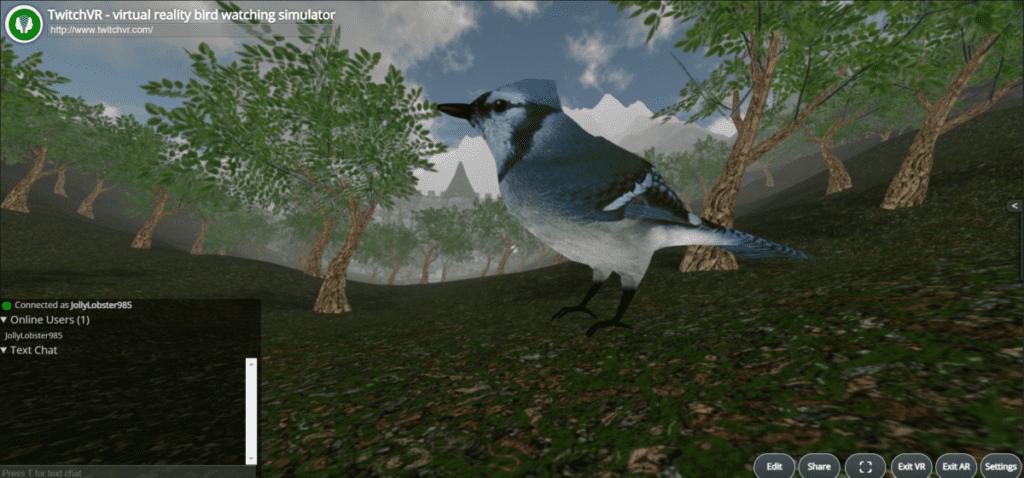
Twitch VR is a simple proof-of-concept birding simulator in which a player can walk through an environment to search for a Bluejay calling in the distance. You first start out beside a massive Bluejay model, and with the help directionally-sensitive calls from the Bluejay, you can make your way to find it in the trees. It’s an interesting concept that has yet to be developed further.
I also noticed some developments for social aspects of the birding simulator, but I was the only one in the game when I went in to try it out… Nevertheless, a great concept. You should definitely try it out! Linked above in the header of this section or here. Here’s a video demonstration from the developer himself:
Birding Simulator Game
Now, this game is an ABSOLUTE treat to the eyes, and I dare say, the closest to the real-life birding experience in this entire article! This birding simulator incorporates aspects of beautiful landscapes that mirror real-life ones, bird photography, and bird watching. Just from looking at the videos of the game, I can already imagine how beautiful the game will play. You can check out a gallery of beautiful virtual pictures of birds on their Instagram page (@birdingsimulator).
You can choose to play the part of a professional ornithologist and bird photographer who is a businessman who returns to his family to find ecological threats in his nearby forest. As a bird photographer, you would be able to adjust photographic parameters and track down rare birds in the forests and other environments available. As a businessman, you can be treated to a full storyline and discover the protagonist’s love for photography and love for nature and the forest.
Here’s a video trailer of the game:
The game is still in development as of the writing of this article and is coming soon! So do make sure to check this game out when it comes out!! I definitely will! Here’s a link to the game if you missed it!
Bird Watching 360 YouTube Videos
Now in recent times, technology has developed so far as to make cameras that record from all angles and these can be uploaded to YouTube as 360-degree videos. 360 cameras have two hemispheres that record 180-degree angles which can be stitched to form a 360-degree video. When these videos are uploaded to YouTube, we viewers can choose to pan and look around! Here are some examples:
Here’s a 360 video of a bird’s nest up close!
If you’re tired of bird watching, here’s a video of an eagle flying with you on its back! This one really took my breath away. What an amazing time to be alive to see what it’s like to be riding on an eagle’s wings.
And also this is a funny one: getting eaten alive by birds!
5. More Advanced Birding Gear
As technology advanced over the past few years, the gear that birders use has also advanced with the times. Here are some examples of how birding gear tech has advanced:
Digiscoping
With the rise of the adoption of smartphones in the past decade, digiscoping has begun to sprout as a habit for many birders who are looking to share their photos of birds quickly and easily on social media sites. If you’ve never heard of the interesting concept of digiscoping, then it’s basically just using a digital camera to take record images or videos through the eyepiece of a telescopic lens. This telescopic lens can be a spotting scope or binoculars.
If you’re a beginner birder, this is also a great way to start taking pictures of the birds you spot without breaking the bank with expensive zoom lenses right off the bat. Here’s a picture of me digiscoping using my binoculars and its result:
Also, if you actually try it out yourself using binoculars, you would find it difficult to align your smartphone with your binoculars. I’ve struggled with it a lot and so I just created a YouTube tutorial on an easy hack to bypass this problem. Have a look at this video:
Waterproof Birding Journal
If you’re someone who commonly encounters rain and also would like to continue documenting your sightings in the rain, then this waterproof birding journal by Rite In The Rain may be of use to you. This was definitely was not something that you would see in the past as all field journals in the past would have been just soaked when the rain comes. However, with modern waterproofing technology, you don’t have to let the rain stop you from documenting the beautiful birds around us! The best part about it? It’s relatively cheap!
Here’s an example and a link to purchase it if you like.
Digital Guide
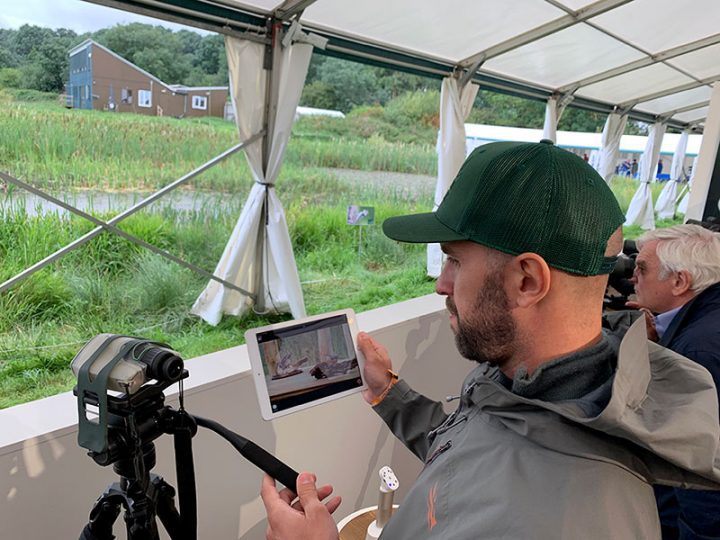
Recently, Swarovski, an optics brand has taken the initiative to start to design a monocular that has an inbuilt digital camera that can pair with and send pictures over to the Merlin Bird ID app for quick identification of birds. This is actually the combination of multiple technologies including digital optics, optical engineering, and computer vision from the Merlin Bird ID app.
Although this invention is not available for the public yet as of this writing, you can try it out at Birdfair in Rutland, England. You read up on more information from an article on the product here.
6. Remote Monitoring For Research
Recording technology has advanced by leaps and bounds over the past few years. Combined with several other types of technologies, remote monitoring of bird sounds has now been made possible! Remote monitoring of bird sounds has been increasingly important to reduce manpower over the years, and has become absolutely essential during the COVID-19 pandemic which spanned throughout the quarantine periods in 2020.
As such, the Institute for Bird Populations in the US has come up with methods to counter this. In order to continue their research during lockdown periods where social distancing is of great importance, they have set up Autonomous Recording Units in their environments to conduct their acoustic surveys. ARUs are an especially helpful technology because it only requires a single person to handle it at one time, reducing the need for more volunteers in the field while ensuring their safety.
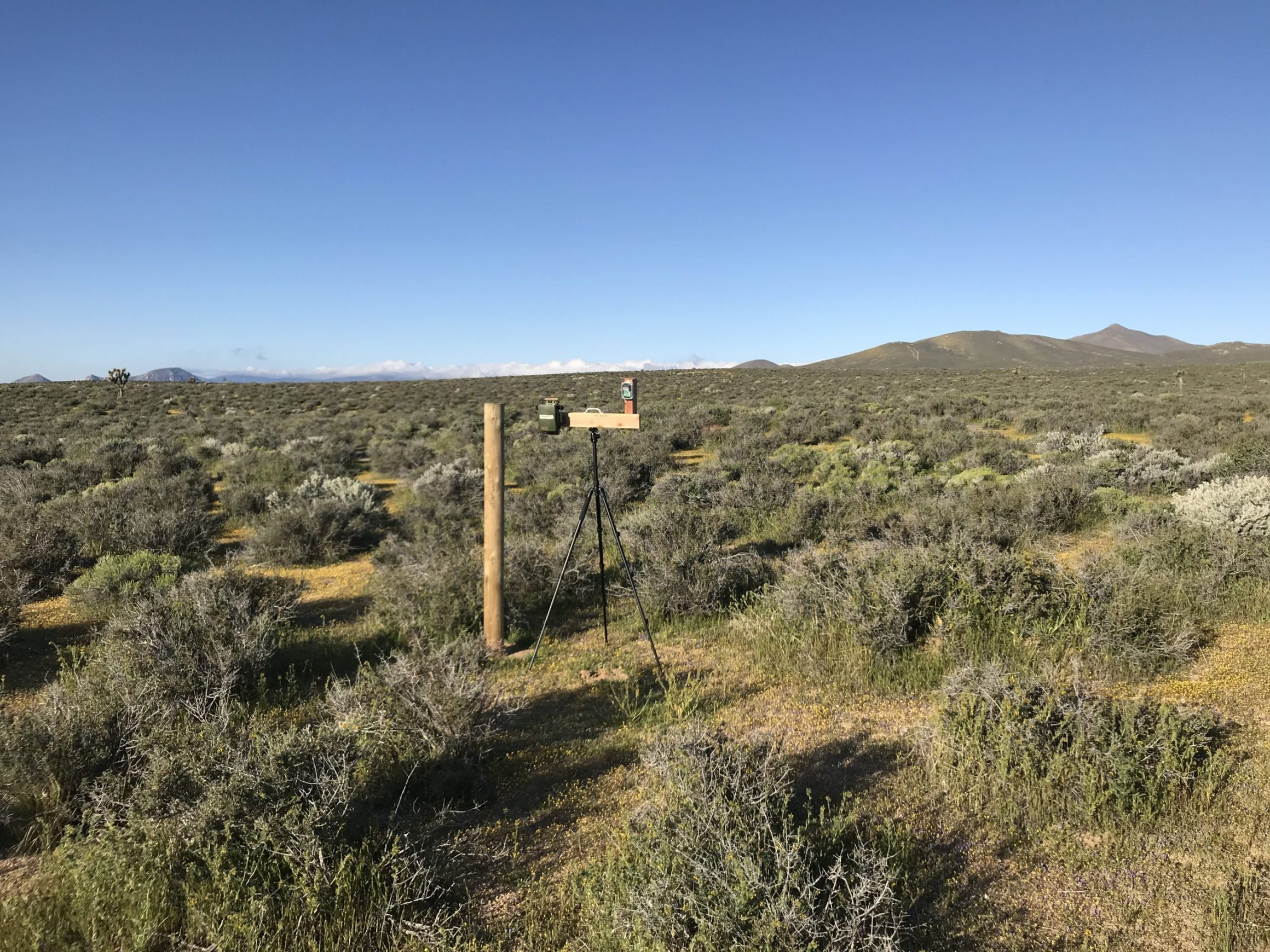
Furthermore, ARUs also provide an unbiased collection of data because they are not prone to observer bias from volunteers. ARUs currently use machine learning algorithms which are currently already deployed in BirdNET, which I described earlier in this article, to recognize bird sounds and identify their species with a certain level of confidence. Because of increased inexpensive storage spaces in the cloud, the costs of data accumulation is low compared to in the past. Another reason why ARUs are so useful is that they can process the sound information and document them almost immediately – much more effective than even a large number of volunteers can!
One thing to take note though, and this is my personal opinion, is that although recording and identification can be automated, it is still for ornithologists and ecology scientists to still continue to take walks in the field to truly understand the data collected!
You can choose to read more information about the remote monitoring project here.
7. Data Science in Birding
Are you also interested in data science like I am? Then this section would be a great read for you. Data science has seen great improvements as a technology over the years. Deep learning models have gone to the point where small differences in morphology in birds are no longer a question.
Struggles that birders face when identifying similar-looking birds are now a thing of the past. In the past, we data scientist birders also struggled to find out the reasons why the algorithms classify a bird a certain way, but now we can infuse interpretation and reasoning to classifications in our deep learning models. I’ll describe more below.
Deep Learning Models
Data scientists such as Daniel Morton has developed deep learning models to help classify bird with subtle differences in recent large fine-grained image classification data sets by the Cornell Lab of Ornithology. What this means is that with such machine learning techniques, once deployed, birders will be able to run their pictures through a program which can tell subtle differences in two very similar-looking birds.
On top of such amazing deep learning models, other data scientists have taken further steps to use a model package called ProtoPNet from scientists from Duke University, to provide reasoning for the classification of birds. This means that the program will be able to explain why it thought that a particular bird is a particular species. In addition to this, it can also provide visual locations of prototypical locations of the picture. What this means is that the program can pinpoint the body part of the bird where the classification decision is made upon.
Here’s an example:
Now that you’ve read about researchers doing their work in the labs and with their cool code, let’s talk more about how these are deployed in actual applications in real life.
Haikubox: A Bird Sound Recognition Birdbox

Haikubox is an ingenious idea for a birdbox! How Haikubox works are that it will automatically detect a birdsong of birds in the area using BirdNET from the Cornell Lab of Ornithology, then send its information over to a website where you can track its details! How cool is that? Imagine being at work and being able to see a list of birds that have visited your backyard! Here’s an article for you to find out more about it.
Warblr: A UK Bird Song ID App

The Warblr app is a smartphone app that was founded by two founders: Florence and Dan. It automatically recognizes birds by their song. It’s simple – you just provide a recording of a bird in question, the app will detect it using machine learning technology, and provide you with images and descriptions of the bird. Its accuracy reaches up to 95% in optimum conditions for over 80 British birds and has participated in the Bird Detection Challenge for remote monitoring purposes. The app is available for both iOS and Android, but only in the UK.
Final Thoughts
Technology has seen huge leaps and bounds in the past few decades and this has also proven its worth in value in birding too! If you’re reading this, then I hope that this article has been of some value to you and that you’ve learned something new about birding tech. Thanks for reading and happy birding!
References
- Venâncio, J.A., Marto, A., Gonçalves, A., Rodrigues, N., & Ascenso, R.M. (2019). Guard@Lis: A new Augmented Reality Mobile Application for Birdwatching. 2019 14th Iberian Conference on Information Systems and Technologies (CISTI), 1-6.
My Recommended Birding Resources:
Hey there, Justin here!
Here’s a list of all my favorite resources, products, and brands I trust and love.
My Celestron Nature DX 8×42 Binoculars: It’s a great budget pair for beginner birders. Highly valued for its price! Read my review.
Safe Paint for Bird Baths Guide: Learn about non-toxic paint for painting bird baths.
Safe Sealers for Bird Baths Guide: Learn which sealers are safe for bird baths.
Safe Paint for Bird Feeders Guide: Learn what special care needs to be taken to paint bird feeders with the right paint.
Safe Paint for Birdhouses Guide: Learn about non-toxic paint for painting birdhouses. (Not the same as bird baths!)
Bird Identification Apps Guide: 2 of my favorite birding apps are Merlin Bird ID, and eBird Mobile! Merlin is great for tracking and identifying birds, and eBird Mobile is great for tracking the birds sighted when birding.
Check out my resources page for the full list of resources I recommend!

Justin Chia
Justin is the founder and author of Birding Outdoors. He is a Nanyang Technological University (NTU) alumnus with a Bachelor of Biological Sciences and a former data analyst.
Now, Justin runs the Birding Outdoors blog full-time, hoping to share his deep love for birds, birding, and nature with others.
To unwind, Justin enjoys gaming and reading.


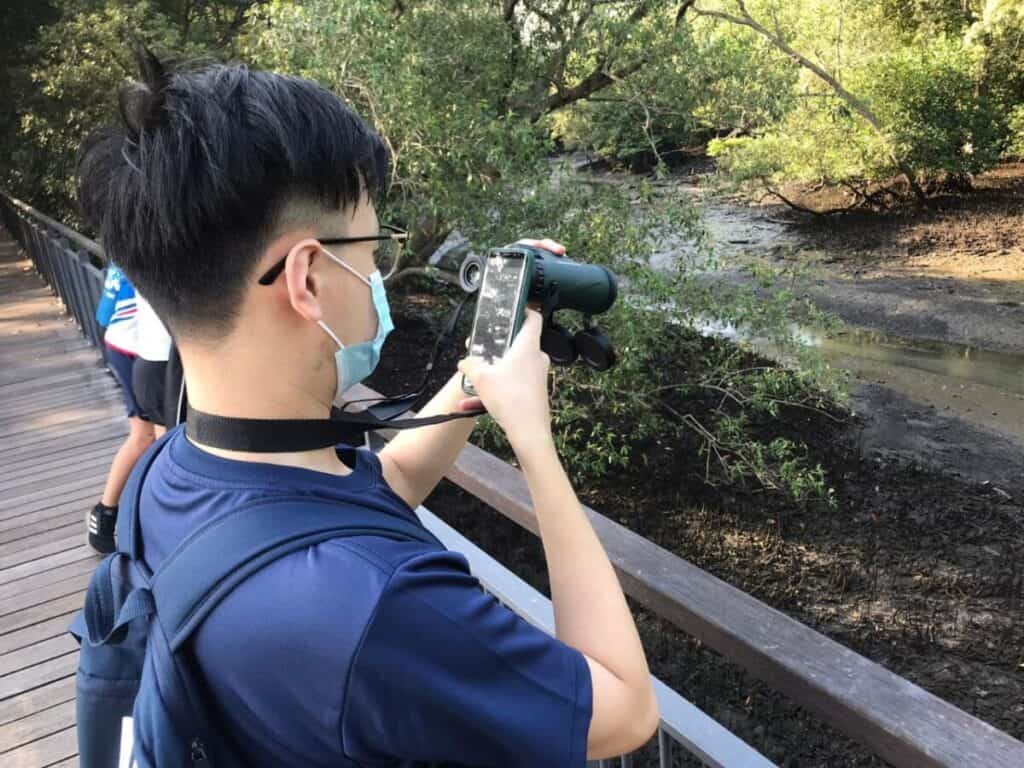
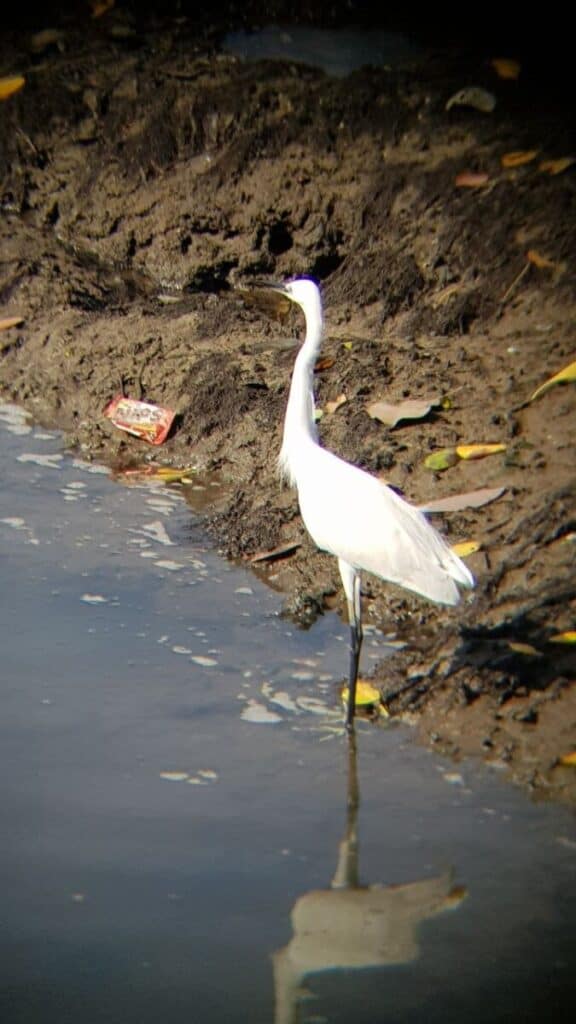

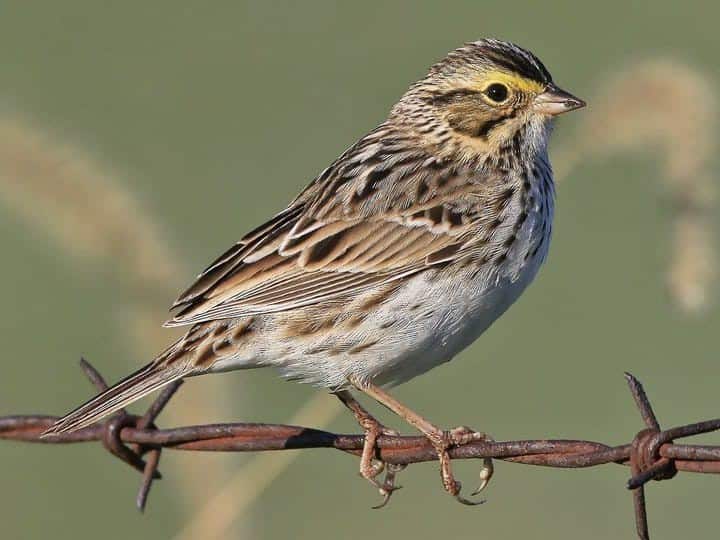

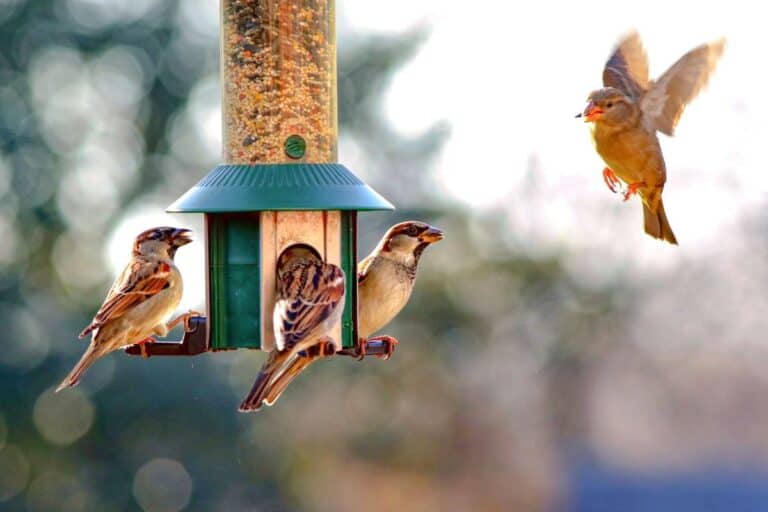
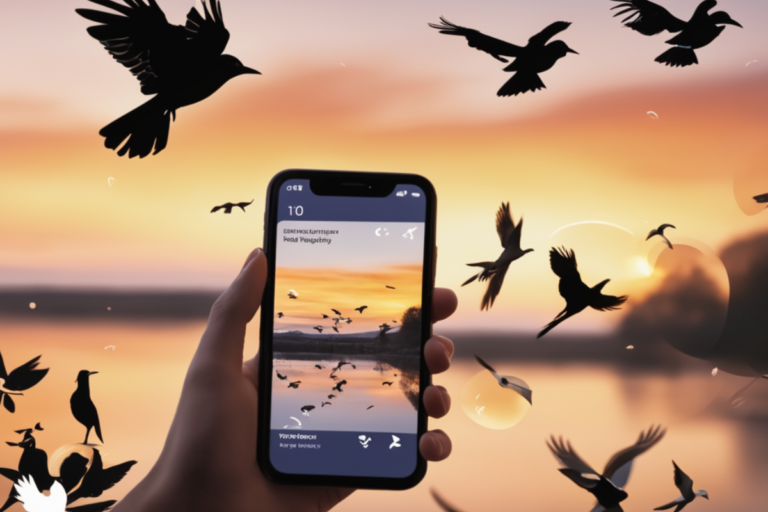


![How Often You Should Change Bird Bath Water [ANSWERED!]](https://birdingoutdoors.com/wp-content/uploads/2021/10/bird-bathing-768x512.jpg)